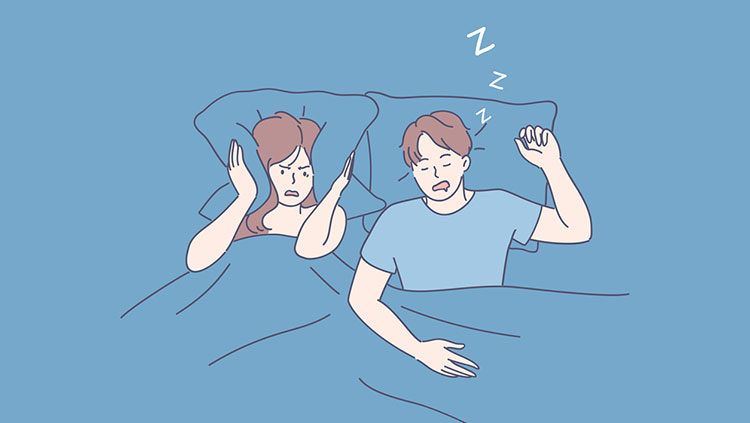How Does Obstructive Sleep Apnea Impact Our Brains and Bodies?
- Published7 Apr 2022
- Author Tristan Rivera
- Source BrainFacts/SfN

Gears grate as you start up your car. So, you turn it off and hear steam exhaling from the engine. By listening, you can tell something is off — but you continue to turn over the engine again, and again, and again.
Something similar can happen as you sleep, sometimes for hours, when you have obstructive sleep apnea (OSA). OSA may induce rotations of choking, gasping, coughing, and loud snoring that can reach decibel levels comparable to a bus cranking up.
Physician-scientist Phyllis C. Zee is a professor of neurology and director of the Center for Circadian and Sleep Medicine at Northwestern University Fienberg School of Medicine: a center dedicated to the diagnosis and treatment of sleep disorders. Dr. Zee established the first circadian medicine clinic in the United States in 2014, housed at Northwestern Medicine. BrainFacts.org spoke with Zee about how OSA can impact a person’s brain and body.
What is OSA?
OSA is a common sleep disorder marked by shallow breathing (hypopneas) or stoppages of breathing (apneas) stemming from recurring blockages to a person’s upper airway. These events last at least 10 seconds and are associated with arousals, a decrease in oxygen levels, changes in heart rate, and changes in blood pressure.
While the most common form of sleep apnea is OSA, a person may have central sleep apnea — a sleep apnea where the internal, physiological signals to breathe are lacking — or a mix of both. You can become deprived of oxygen as you breathe less throughout the night with either type of sleep apnea. This lack of oxygen can result in cascading impacts on your brain anatomy and function, cause downstream health complications, and contribute to disease formation and progression.
How does OSA impact a person’s normal sleep-wake cycle?
OSA will clearly disrupt and fragment sleep. OSA induces multiple arousal and awakening events throughout the sleep cycle as a person’s brain will frequently wake them up to start to breathe again. These events can occur hundreds of times in a night and tend to occur more frequently during the rapid eye movement (REM) sleep and deep sleep phases. While awake, a person with OSA may experience more excessive daytime sleepiness, decreases in alertness, mood disorders, cognitive impairment, and changes in behavior. People may also be more fragmented during their wakefulness, sleeping more often throughout the wake cycle. From a performance behavior standpoint — this can diminish a person’s ability to drive and increase the risk of getting in an accident. In children with OSA, this can lead to an increased risk of being diagnosed with ADHD.
What are some of the effects of OSA on a person’s brain anatomy and function?
OSA disturbs sleep and decreases the amount of oxygen received by the brain. In the long term, a person with OSA is at an increased risk for stroke, Alzheimer’s disease, other neurodegenerative disorders, and potentially even hearing loss from the volume of their own snoring throughout the night. Other common comorbidities with OSA include obesity and diabetes.
OSA causes more immediate impacts on the brain as reflected by its impairments to the sleep-wake cycle. The lack of oxygen likely causes wholescale impacts on brain function, with pronounced negative consequences on the brain areas regulating autonomic activity and areas associated with memory and alertness.
However, it’s harder to determine some of the more acute effects that OSA directly exerts on the brain. We can experimentally induce OSA to understand some of these acute effects. There, we see things like changes in blood rate delivery to organs or tissues, alterations in autonomic nervous system functioning, and decreases in overall oxygen levels.
But sleep apnea tends to be very underdiagnosed; usually by the time there is a diagnosis, it’s been years. Witnessed apneas — or reported apneas, commonly told by a “sleep witness” or bed partner — often time tend to precede OSA diagnosis. And since a person may not be aware that they have OSA, that person is more likely to seek treatment when nudged by another.
How are you and other researchers working to better understand and treat OSA?
The good news: it’s treatable. The current primary treatment method is continuous positive airway pressure (CPAP) therapy. CPAP therapy consists of sleeping with a machine that allows people to breathe air at slightly higher pressures than normal. These pressures can be adjusted manually or automatically depending on the machine to cater to person’s breathing patterns. However, some people have a lot of difficulty with the treatment and cannot tolerate it. So, we're trying to understand the mechanisms underlying OSA to improve targeted therapies.
One such therapy that we had an NIH grant for was to look at the effect of cannabinoids in OSA. While it didn’t cure OSA, it did show some potential symptom improvement. We’re also looking at pharmacological treatments to enhance muscle tone and breathing.
But sleep studies also tend to be costly and not easily accessible. They can range from around $150-$500 for at-home tests and $1000-$3000 or more for overnight laboratory exams. So, we’re trying to develop more cost effective, readily accessible diagnostic sensory technology to screen and diagnose OSA in the general population more easily.
I think sleep in particular is a hugely collaborative field. Many of the collaborations across OSA research include people who study biomedical engineering, material sciences, genetics, machine learning, neuroscience, pulmonology, and other fields. The advances in computerization, and our ability to be more quantitative with research, has been key for us to even attempt to move beyond what we did just 15-20 years ago.
References
Andrews, M. (2021). A $10,322 Tab For A Sleep Apnea Study Is Enough To Wreck One Patient's Rest. All Things Considered. National Public Radio. https://www.npr.org/sections/health-shots/2021/05/27/1000494207/a-10-322-tab-for-a-sleep-apnea-study-is-enough-to-wreck-one-patients-rest
Atkeson, A., Yeh, S. Y., Malhotra, A., & Jelic, S. (2009). Endothelial function in obstructive sleep apnea. Progress in cardiovascular diseases, 51(5), 351–362. https://doi.org/10.1016/j.pcad.2008.08.002
Conhaim, R. L., Watson, K. E., & Teodorescu, M. (2019). Obstructive apnea causes microvascular perfusion maldistribution in the lungs of rats. American Journal of Physiology-Regulatory, Integrative and Comparative Physiology, 316:1, R21-R26. https://doi.org/10.1152/ajpregu.00243.2018
Daulatzai, M. A. (2012). Pathogenesis of Cognitive Dysfunction in Patients with Obstructive Sleep Apnea: A Hypothesis with Emphasis on the Nucleus Tractus Solitarius. Sleep Disorders, 2012: 251096. https://doi.org/10.1155/2012/251096
Hooper R. G. (2020). CPAP Therapeutic Options for Obstructive Sleep Apnea. Pragmatic and observational research, 11, 67–76. https://doi.org/10.2147/POR.S258632
Kaul, M., Zee, P. C., & Sahni, A. S. (2021). Effects of Cannabinoids on Sleep and their Therapeutic Potential for Sleep Disorders. Neurotherapeutics, 18(1): 217–227. https://doi.org/10.1007/s13311-021-01013-w
Macey, P. M. (2012). Is Brain Injury in Obstructive Sleep Apnea Reversible? SLEEP, 35(1): 9–10. https://doi.org/10.5665/sleep.1572
Marks, J. (2021). The Cost of Sleep Apnea. WebMD. Retrieved on March 30, 2022 on https://www.webmd.com/sleep-disorders/sleep-apnea/cost-of-sleep-apnea.
Sforza, E. & Roche, F. (2012). Sleep apnea syndrome and cognition. Frontiers in Neurology, 3. https://doi.org/10.3389/fneur.2012.00087
Spain, E. (2018, Sep 18). New Ways to Diagnose Sleep and Circadian Rhythm Disorders with Phyllis Zee, MD, PhD. Northwestern University Fienberg School of Medicine. https://www.feinberg.northwestern.edu/research/news/podcast/sleep-and-circadian-rhythm-disorders.html
Vanek J., Prasko J., Genzor S., Ociskova M., Kantor K., Holubova M., Slepecky M., Nesnidal V., Kolek A., & Sova M. (2020) Obstructive sleep apnea, depression and cognitive impairment. Sleep Med, 72:50-58. https://doi.org/10.1016/j.sleep.2020.03.017
Weeks, K. D. (2012, November 30). The Basics of Obstructive Sleep Apnea. The American College of Cardiology. Retrieved February 18, 2022 from https://www.acc.org/latest-in-cardiology/articles/2014/08/21/14/05/the-basics-of-obstructive-sleep-apnea
BrainFacts.org welcomes all your brain-related questions.
Every month, we choose one reader question and get an answer from a top neuroscientist. Always been curious about something?
Please submit your question by filling out this form.







